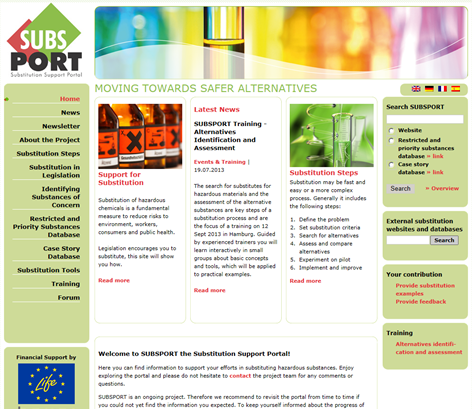Occupational Health and Safety Management Tools: A review for EU-OSHA
1 Sep 2014
Sally Wilson, Senior Research Fellow
 The European Agency for Safety and Health at Work (EU-OSHA) is committed to making Europe a safer, healthier and more productive place to work. An issue of ongoing concern for it is the difficulty that small and medium-sized enterprises (SMEs) can face in implementing effective management of safety and health at work. Some smaller employers can struggle with the expense of occupational safety and health (OSH) advice: the costs of specialist consultants can be prohibitive, while printed or web-based sources produced by government or industry bodies may be too generic to be useful. In recognition of this, an important aspect of EU-OSHA’s role is to support the design and development of hands-on instruments for micro, small and medium-sized enterprises to help them assess and manage workplace risks.
The European Agency for Safety and Health at Work (EU-OSHA) is committed to making Europe a safer, healthier and more productive place to work. An issue of ongoing concern for it is the difficulty that small and medium-sized enterprises (SMEs) can face in implementing effective management of safety and health at work. Some smaller employers can struggle with the expense of occupational safety and health (OSH) advice: the costs of specialist consultants can be prohibitive, while printed or web-based sources produced by government or industry bodies may be too generic to be useful. In recognition of this, an important aspect of EU-OSHA’s role is to support the design and development of hands-on instruments for micro, small and medium-sized enterprises to help them assess and manage workplace risks.
To support this aim, EU-OSHA recently asked IES to conduct a review of online OSH management tools so that it could gain a better understanding of the various online instruments available in Europe that provide OSH know-how. For the purposes of the research the Agency defined an online OSH tool as a piece of software that:
- can run on the internet, on a computer, or on a phone or other electronic device,
- can be connected to a system (as opposed to ’offline’),
- is interactive because it requires some active decision-making from the user, and guides them through the process (as opposed to a static or passive instrument such as traditional factsheets or checklists).
To meet EU-OSHA’s requirements IES’s review comprehensively documented the range of online OSH tools available in 27 EU Member States and provided a typology of tools. Another key component of the work comprised reviewing nine OSH tools in some depth and describing their format and function. IES researchers interviewed staff involved in the production of each tool to identify key features of the development process and various challenges that would need to be addressed to enable wider usage across the EU. Finally, drawing on consultation with EU social partners and national health and safety representatives, the report recommended possible approaches that EUOSHA could take to supporting wider use of online OSH tools.
Examples of online OSH tools
Three representative examples of tools that were reviewed in depth are described below: these illustrate the range available and how they vary in terms of accessibility and complexity.
SUBSPORT
The goal of SUBSPORT, the development of which was funded by a multinational consortium of public-sector organisations, is to provide an internet portal that constitutes a state-of-the-art resource on safer alternatives to the use of hazardous chemicals. A particular aim of this OSH tool is to support companies of all sizes in fulfilling substitution requirements of EU legislation, for example those specified under the Regulation on Registration, Evaluation, Authorisation and Restriction of Chemicals (REACH). As well as being a source of information on alternative substances and technologies, SUBSPORT also provides tools and guidance for substance evaluation and substitution management. Furthermore, this OSH Tool supports the creation of a network of experts and stakeholders actively involved in chemical substitution. This network assists in both content development and promotion of the tool to ensure sustainability of the site.

A screenshot of the SUBSPORT website
Løfte (‘Lifting’/ manual handling)
This Danish tool allows identification of health risks associated with lifting regularly or lifting heavy loads in the workplace. It can be used by anybody concerned with these issues as well as employers or representative bodies. However, at present, the tool is only available in Danish.
The tool is a so-called ‘living app’, which assesses risks associated with lifting for individual workers and is based on Danish health and safety legislation. However, IES found no reason why this application could not be translated and modified to fit other regulatory contexts in the EU.
Psychological health promotion as a leadership task
This e-learning tool is a product of Psyga, a German consortium, which specialises in the area of psychosocial health issues in the workplace. The motivation behind its development was to reach their target groups (ie people managers) more effectively than was possible through paper-based material. The tool focuses specifically on what managers can do to foster psychological well-being and guides users through a series of informative and interactive slides which illustrate the link between job performance and psychological wellbeing. Practical advice is also provided, particularly in regard to managing workrelated stress. At the end of the slides, a checklist allows users to assess their knowledge of the subject area.
Conclusions
The above small selection of tools highlights several important issues that IES recommended EU-OSHA consider when developing its strategy for online OSH tools. For example, although all the reviewed tools are cost-free to access, currently each is available in only one or a limited number of languages. Further, widening access across national borders requires that attention be given to content as well as language: although regulations for health and safety measures are the same throughout Europe, Directives have to be altered to fit into the national law of member states. This means that health and safety law can differ between European Union (EU) Member States and some degree of tailoring is necessary for materials to be used by different audiences.
Other practical considerations arise when considering investment in further development of the identified tools: for example, the need to ensure that tools stay up to date (with respect to technological innovation and knowledge generated from research) and oversight of administrative and ownership issues such as copyright and intellectual property (IP) concerns. Also, the maintenance and development of interactive multimedia tools requires high-level expertise in software development, especially if it is desirable that the content is accessible from smart phones and tablets as well as PCs.
Regardless of these difficulties, there is potential for these tools to help reduce work-related accidents and ill health across the EU, especially if they remain free to use and resources are invested in translation and adaptation. The tools allow employers to be instrumental in the OSH management process, allowing them engagement with a process that would not be possible otherwise. Newer generations of employers are comfortable with IT and expect it to facilitate most aspects of their working and personal lives. Therefore there was a strong view among health and safety experts interviewed for the project that online OSH tools represent the future.

